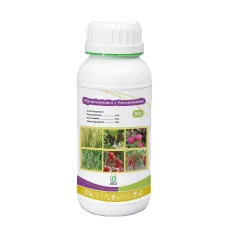
Jul . 21, 2025 14:04 Back to list
The Science of Effective Weed Control with Herbicide in Modern Agriculture
In today's agricultural landscape, herbicides play a pivotal role in ensuring optimal crop yields by controlling invasive weeds that compete for nutrients, water, and sunlight. Among the most effective solutions are aminopyralid herbicide, versatile chemical herbicide formulations,and specialized corn herbicides designed to protect our most vital crops. This comprehensive guide explores these powerful weed control solutions, their applications in major crops (including corn, wheat, soybeans, potatoes, and fruit orchards), and best practices for maximizing their effectiveness while ensuring crop safety.

Aminopyralid Herbicide: Targeted Control for Tough Broadleaf Weeds
Aminopyralid herbicide represents a breakthrough in selective weed control, particularly effective against persistent broadleaf weeds while showing excellent crop safety in grasslands and pastures.
Key Applications in Major Crops:
Corn Fields: Controls invasive weeds like Canada thistle and field bindweed without damaging corn plants
Wheat and Barley: Provides season-long protection against difficult broadleaf weeds
Pastures and Rangeland: Selective action preserves desirable grasses while eliminating toxic weeds
Unique Advantages:
✔ Ultra-low use rates (as little as 2-5 oz/acre)
✔ Long residual activity (up to 18 months control)
✔ Excellent rainfastness (within 1 hour of application)
✔ Safe for grass crops and rotational programs
Farmers appreciate aminopyralid herbicide for its ability to control weeds that have developed resistance to other herbicide classes, making it an essential tool in integrated weed management systems.
Chemical Herbicide Options for Diverse Agricultural Needs
Modern chemical herbicide solutions offer farmers a range of options to address specific weed challenges across different crops and growing conditions.
Herbicide Types and Their Uses:
|
Herbicide Class |
Target Weeds |
Best Crop Uses |
|
Sulfonylureas |
Broadleaf & grasses |
Wheat, rice, soybeans |
|
Triazines |
Annual broadleaves |
Corn, sorghum, sugarcane |
|
PPO Inhibitors |
Resistant pigweeds |
Soybeans, vegetables |
|
ACCase Inhibitors |
Grass weeds |
Cereals, orchards |
Application Considerations:
Pre-emergence vs. Post-emergence timing
Soil type influences herbicide persistence
Weather conditions affecting application efficacy
Tank mix compatibility with other crop inputs
The strategic use of chemical herbicide products allows for customized weed management programs tailored to specific crop needs and local weed pressures.
Corn Herbicides: Specialized Solutions for America's Top Crop
With corn covering over 90 million acres in the U.S. alone, specialized corn herbicides are essential for protecting this vital crop from yield-robbing weeds.
Herbicide Program Options for Corn:
Pre-Plant/Burndown:
Controls existing weeds before planting
Often combines glyphosate with residual products
Pre-Emergence:
Forms protective barrier in soil
Includes products like atrazine, mesotrione, and S-metolachlor
Post-Emergence:
Targets escaped weeds
Features aminopyralid herbicide combinations for tough broadleaves
Includes new HPPD inhibitor technologies
Resistance Management Strategies:
Rotate herbicide modes of action annually
Use layered residual programs
Combine mechanical and chemical control
Implement field sanitation practices
Modern corn herbicides not only control weeds but also help preserve soil moisture and reduce mechanical damage to crops from cultivation.
Herbicide Application Best Practices for Field Crops and Specialty Crops
Proper application techniques maximize herbicide effectiveness while minimizing risks to crops and the environment.
Application Methods by Crop Type:
Field Crops (Corn, Soybeans, Wheat):
Ground rig spraying (15-20 GPA)
Aerial application for timely coverage
Precision spray technologies
Vegetables (Potatoes, Onions, Peppers):
Shielded sprayers
Drip chemigation
Directed spraying
Fruit Crops (Apples, Oranges, Grapes):
Airblast sprayers
Wicking applicators
Basal bark treatments
Key Considerations:
Nozzle selection (drift reduction vs. coverage)
Water quality impacts (pH, hardness)
Temperature inversions and spray timing
Adjuvant selection for enhanced performance
Following label instructions precisely ensures both effective weed control and compliance with environmental regulations.
FAQs About Modern Herbicides
1. What makes aminopyralid herbicide different from other weed controls?
Aminopyralid herbicide stands out for its exceptional activity on difficult perennial broadleaf weeds at very low use rates, with extended soil residual that provides season-long control while being safe for grass crops.
2. How do I choose the right chemical herbicide for my operation?
Selection should be based on your specific weed spectrum, crop rotation, soil type, and resistance management needs. A layered approach using multiple effective modes of action provides the best long-term results.
3. What are the newest developments in corn herbicides?
Modern corn herbicides now feature advanced combinations with multiple effective modes of action, improved crop safety traits, and formulations designed for better rainfastness and residual control.
4. How can I prevent herbicide resistance in my fields?
Implement a resistance management program that includes rotating herbicide groups, using tank mixes with multiple effective modes of action, incorporating mechanical controls, and maintaining good records of previous herbicide use.
5. What's the proper way to clean spray equipment after using aminopyralid herbicide?
Thoroughly triple-rinse tanks with water and ammonia solution (1% household ammonia), flush hoses and nozzles, and avoid using equipment treated with aminopyralid herbicide on sensitive crops without proper decontamination.
-
Tembotrione Mode of Action in Weed Control
NewsJul.21,2025
-
Safety Guidelines for Handling Atrazine in Farming
NewsJul.21,2025
-
Mesotrione Residue Management in Crops
NewsJul.21,2025
-
How Topramezone Controls Resistant Weed Species
NewsJul.21,2025
-
How to Properly Handle Glufosinate Ammonium
NewsJul.21,2025
-
Best Practices for Applying 2 4d Herbicide
NewsJul.21,2025
